An interesting visitor came to Istanbul last week, Al Smith, the St. Paul restauranteur. Al was a 3M vice president back in 1980, when Sankar started at the company, and he was approachable enough that a young engineer became acquainted with him. Sankar and Al have kept in touch over the past thirty years, and during our dinner here in Istanbul, I learned more of Al’s story.
“Fifty years ago,” Al reminisced, “3M sent us to Italy.” In 1961, he and his wife Lucille and their two children moved from St. Paul to Casserta, in southern Italy, where 3M had manufacturing facilities. They fell in love with Italy, picking up the language and making friendships they have kept to this day. Their tour lasted for eleven years – and Lucille gave birth to four more children in Italy. The Italians were amazed at this growing American family, and would tell Lucille, “You are such a good girl.”
Back in the States, Al retired early to focus on serving authentic Italian food, and his St. Paul restaurants, Luci and Luci Ancora, have thrived. Several of Al’s children are involved in daily management, but he still keeps an eye out for ingredients. He visited Istanbul’s Spice Bazaar on his first day here, purchasing $600 worth of Iranian saffron and locating a new pine nut supplier.
I have started Turkish lessons just a few blocks south of the Cirağan Palace Hotel, where Al and his family stayed. My tutor, Ferda, and I meet at the Besiktas pier every Friday after work, sitting down at a lovely oceanside restaurant whose management does not seem to care that in two hours we order only tea. As we struggled over verb forms the other day, I realized I was getting too wrapped up in what was on the paper. I was failing to appreciate the large and small boats coming and going and the afternoon sunlight playing off the big old wooden Ottoman houses lining the opposite shoreline. One can become blasé in the most exotic of places.
After our lessons, the sea road back to our apartment is generally jammed with traffic, so I walk home. I pass the Four Seasons, where 3M put us up on our “look-see” visit back in January, 2010. I remember how we ventured out in the weak winter daylight and examined the slightly gritty neighborhood near the hotel. Elegance and timidity are my most vivid recollections of that seemingly long-ago time.
Past the hotel, the street is shaded by plane trees, and on my left is a series of shiny black and white enlarged photographs depicting Kemal Atatürk’s life. Like others who regularly take this road, I have sat in traffic and studied each of these photos carefully. There are pictures of Atatürk in his soldier days and numerous photos of him at official events when he led the new Turkish Republic. My favorite, perhaps not surprisingly, is one that shows him explaining Turkey’s 1928 change to the Roman alphabet, when the Arabic script was abandoned. He brushed off protests, saying, “It will only take you a few days to learn,” and maybe he was right; in those days the majority of Turks were illiterate.
I walk past the Cirağan Palace, formerly a Sultan’s residence, and think again about how Al and his family fell in love with a new country. This topic keeps returning to my mind because I feel my affection for Turkey growing. What might I do with these startling new sentiments when I return? Alas, Al was in his early forties when he returned from Italy; I will be in my late fifties. The years accumulate inexorably.
Further along the road, the traffic stops entirely as two lanes become one and cars from side street attempt to merge. We are close to “The First Bridge” now, a suspension affair that was built over the Bosphorus in 1973. (The Second Bridge joined it in 1988 and another is planned.) It seems hard to believe that until then, boats were the only way to cross to the Asia side.
Now I’m in Ortaköy, a charming urban village with eclectic buildings, among them public baths build in the 1570s and a synagogue that dates back to the seventeenth century. On my right are tiny shops with ceramic souvenirs, clothing stores including the too-cute-for-words Yargici, which opened a branch in Paris last year, and a maze of winding streets that lead to seaside restaurants and an ornate 1853 mosque. Ortakoy’s most famous food is kumpir, baked potatoes stuffed with all sorts of toppings including sweet corn, cheese, olives, sausage, mushrooms, and a mixture of mayonnaise and ketchup that runs together on top of the spud, turning an alarming shade of pink. I haven’t tried it yet.
Past Ortakoy a string of fashionable nightclubs with names like Reina, Sortie and Anjelique; a lovely seaside park with winding paths; and the Turkcell stadium where blowout concerts are held even on weeknights (last month: Ricky Martin; this month: Bon Jovi).
Next, Arnavutkoy, lined with Ottoman row houses remiscent of San Francisco’s painted ladies. A mouth-watering glance at the fruit market there, bursting with peaches, apricots, melons and cherries this time of year, and then I turn to walk up the 600 foot hill to our apartment. As I climb, I wave to the tailor, the fruit seller, the baker, and a friendly realtor, and stop to pluck mulberries from roadside trees to sustain me for the final ascent.
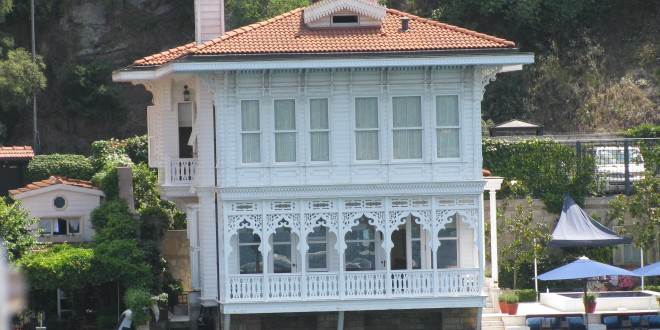
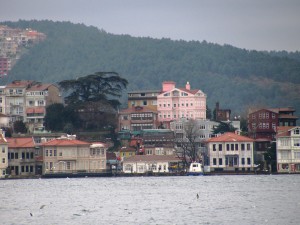

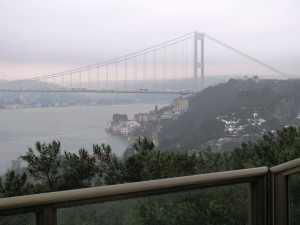
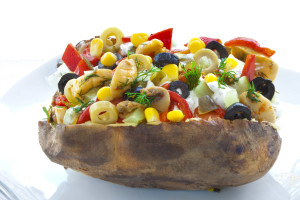
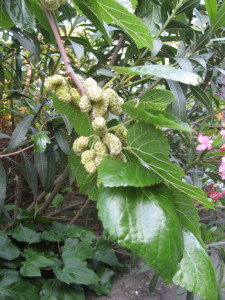
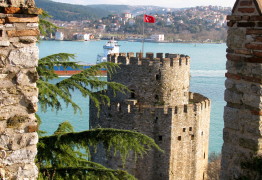
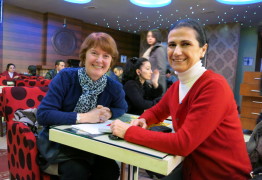
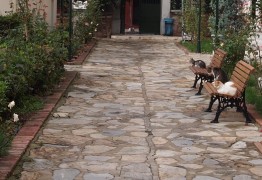
It is such a pleasure to read about your fabulous life on your beautifully written blog. Thank you!
Your words paint a vivid picture. Maybe you will open a Turkish restaurant when you return? You are still young with so much to offer the world!
I think you can forget about kumpir!!! Even the name is a made-up one. They look gross!!! But I love your post! Thank you.
Sue, I have just nominated you to participate in the 7 Links Project initiated by TripBase. Check out my blog for details.